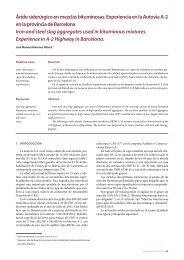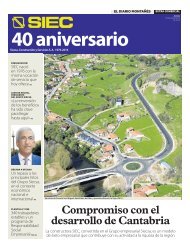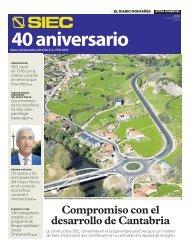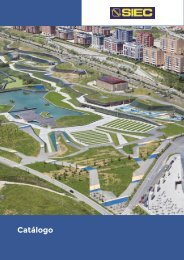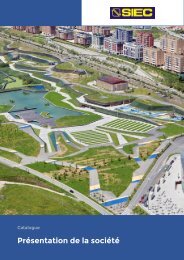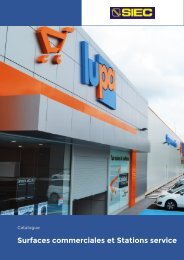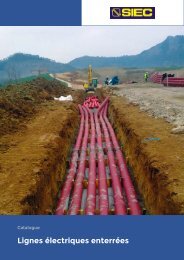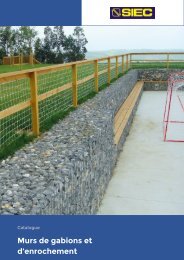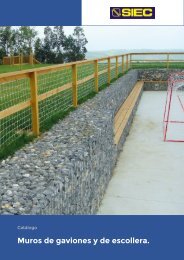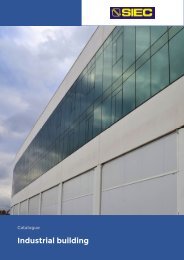1.- Stabilization of slopes and embankments
You also want an ePaper? Increase the reach of your titles
YUMPU automatically turns print PDFs into web optimized ePapers that Google loves.
Catalogue<br />
<strong>Stabilization</strong> <strong>of</strong> <strong>slopes</strong> <strong>and</strong> <strong>embankments</strong>
INDEX:<br />
<strong>1.</strong>- <strong>Stabilization</strong> <strong>of</strong> <strong>slopes</strong> <strong>and</strong> <strong>embankments</strong>.<br />
<strong>1.</strong><strong>1.</strong>- Micropile.<br />
<strong>1.</strong>2.- Lanes jacking.<br />
<strong>1.</strong>3.- Breakwaters.<br />
<strong>1.</strong>4.- Anti-erosion protection.<br />
<strong>1.</strong>5.- Gunite or shotcrete.<br />
<strong>1.</strong>6.- Anchors, mesh <strong>and</strong> cable networks.<br />
<strong>1.</strong>7.- Stone columns.
Catalogue<br />
<strong>Stabilization</strong> <strong>of</strong> <strong>slopes</strong> <strong>and</strong> <strong>embankments</strong><br />
<strong>1.</strong>- STABILIZATION OF SLOPES AND EMBANKMENTS.<br />
Since our inception we have carried out numerous works <strong>of</strong> maintenance <strong>and</strong> upkeep <strong>of</strong> roads for the<br />
various regional roads, public authorities, Ministry <strong>of</strong> public works <strong>and</strong> municipalities. Our specialization in<br />
the stabilization <strong>of</strong> <strong>slopes</strong> <strong>and</strong> hillsides has emerged out <strong>of</strong> here. So much so that in collaboration with the<br />
Ministry <strong>of</strong> development <strong>and</strong> the society for regional development <strong>of</strong> Cantabria (Sodercan) <strong>and</strong> the Group<br />
<strong>of</strong> research <strong>of</strong> technology <strong>of</strong> the construction <strong>of</strong> the University <strong>of</strong> Cantabria have carried out various<br />
conventions for the study <strong>and</strong> publication <strong>of</strong> a manual for the "stabilization <strong>of</strong> <strong>slopes</strong> by driven railway<br />
Rails",aswellastheGuideon"Implementation <strong>of</strong> walls <strong>of</strong> breakwater road".<br />
Slope stabilisation methods can be grouped into two containment systems <strong>and</strong> methods that increase the<br />
resistance to cutting <strong>of</strong> the floor.<br />
<strong>Stabilization</strong> <strong>of</strong> slope on motorway A-8 (Asturias), Spain.<br />
Belong to the first group, systems that generate a continuous force that opposes the movement <strong>of</strong> soil,<br />
such as reinforced concrete walls, walls <strong>of</strong> breakwater, gravity walls, screens <strong>of</strong> piles, reinforced concrete<br />
continuous screens, dynamic displays, etc. These methods do not dem<strong>and</strong> <strong>of</strong> field collaboration resistant,<br />
being the structure which stabilises the soil. The second group is characterized by raising the global<br />
resistance <strong>of</strong> the soil by the inclusion <strong>of</strong> structures or with the improvement <strong>of</strong> the soil. You can mention<br />
in these systems, the grouting, the reinforced earth, displays <strong>of</strong> nuts <strong>and</strong> bolts, Californians, sewing pile or<br />
Rails, drains etc.<br />
We want to highlight the most common building systems, containment <strong>and</strong>/or stabilization <strong>of</strong> <strong>slopes</strong> <strong>and</strong><br />
<strong>slopes</strong> that we have been running being our high level <strong>of</strong> expertise with our experience the best guarantee<br />
for our clients.
<strong>1.</strong><strong>1.</strong>- MICROPILES.<br />
They are elements <strong>of</strong> deep foundations, <strong>of</strong> circular cross‐section <strong>and</strong> small diameter up to 350 mm,<br />
with a high load‐bearing capacity to compression, which transfer the loads to the ground in depth.<br />
Similarly, the micropiles can be designed to withst<strong>and</strong> bending <strong>and</strong> cutting, <strong>and</strong> even traction. They<br />
are drilled into the ground, armed with a pipe <strong>of</strong> steel <strong>of</strong> high resistance, pr<strong>of</strong>iles or bars <strong>and</strong> injected<br />
with grout or mortar bed, covering the armor <strong>and</strong> getting optimum adhesion to the ground.<br />
Example <strong>of</strong> micropiles as containment or support structure.<br />
<strong>1.</strong>‐ <strong>Stabilization</strong> <strong>of</strong> <strong>slopes</strong> <strong>and</strong> <strong>embankments</strong>
Catalogue<br />
<strong>Stabilization</strong> <strong>of</strong> <strong>slopes</strong> <strong>and</strong> <strong>embankments</strong><br />
Drilling anchors.
<strong>Stabilization</strong> <strong>of</strong> slope in AC-282 in La Hermida (Cantabria).<br />
<strong>1.</strong>‐ <strong>Stabilization</strong> <strong>of</strong> <strong>slopes</strong> <strong>and</strong> <strong>embankments</strong>
Catalogue<br />
<strong>Stabilization</strong> <strong>of</strong> <strong>slopes</strong> <strong>and</strong> <strong>embankments</strong><br />
<strong>1.</strong>2.- LANES JACKING.<br />
He is meant by this piling method <strong>of</strong> railway rails in an unstable slope in order to intercept the<br />
sliding surface, giving it the cutting needed to stop or minimize the movement <strong>of</strong> the slope. When<br />
proposing this kind <strong>of</strong> works, usually slip has already said they have taken into account <strong>and</strong><br />
analyzed the geotechnical, structural, construction, environmental <strong>and</strong> economic aspects <strong>of</strong><br />
performance, <strong>and</strong> above all the reason <strong>and</strong> the mechanisms that originated the movement so that<br />
it does not become manifest once installed the containment system.<br />
The types <strong>of</strong> Rails used in Spain are two, UIC 45 (via close) <strong>and</strong> UIC 54. Rails quite well resist efforts<br />
to Court <strong>of</strong> the l<strong>and</strong>. Nominal admissible resistances <strong>of</strong> the rails are in the order <strong>of</strong> 1400 Kn. Digs<br />
on the Rails, depend on the separation that they have in the design <strong>and</strong> in the field. This<br />
configuration will result in the number <strong>of</strong> lanes per row <strong>and</strong> per linear meter <strong>of</strong> talus. The most<br />
appropriate method is used depending on the type <strong>of</strong> sliding <strong>of</strong> the slope being the most widely<br />
used finite slope method usually glides have semicircular shape.<br />
They are normally forming alignments or groups with various inclinations, encepan head <strong>and</strong><br />
accompanied by anchors or other units <strong>of</strong> work. Theyareplacedinthesameplane(usually<br />
vertical) or forming range.<br />
Example <strong>of</strong> stabilization <strong>of</strong> <strong>slopes</strong> or hillsides.
He piling lane for stabilization <strong>of</strong> CA-182 in Carmona (Cantabria).<br />
Detail <strong>of</strong> the upper bound <strong>of</strong> the due.<br />
<strong>1.</strong>‐ <strong>Stabilization</strong> <strong>of</strong> <strong>slopes</strong> <strong>and</strong> <strong>embankments</strong>
Catalogue<br />
<strong>Stabilization</strong> <strong>of</strong> <strong>slopes</strong> <strong>and</strong> <strong>embankments</strong><br />
Tied <strong>and</strong> formwork due higher.
<strong>1.</strong>3.- BREAKWATERS.<br />
They are understood by irregular walls <strong>of</strong> placed rockfill, the composed <strong>of</strong> blocks <strong>of</strong> rock, polyhedral,<br />
uncut form <strong>and</strong> large size (between 300 <strong>and</strong> 3000 kg mass), which are placed one by one using<br />
specific machinery, with containment or support functions. The placement <strong>of</strong> each <strong>of</strong> the blocks<br />
should be conducted on an individual basis, taking into account the shape <strong>and</strong> size <strong>of</strong> the<br />
immediately surrounding area, so that the whole present lower volume <strong>of</strong> holes as possible, getting<br />
high values <strong>of</strong> the apparent specific gravity <strong>of</strong> placed rockfill <strong>and</strong> good stability <strong>of</strong> the wall.<br />
Distinguishes two types <strong>of</strong> wall, in accordance with the mission that was entrusted to them:<br />
a) retaining walls <strong>of</strong> <strong>slopes</strong> <strong>and</strong> <strong>embankments</strong> in dismantling (<strong>of</strong> contention).<br />
b) Walls <strong>of</strong> fillings (support) support.<br />
a) Retaining walls <strong>of</strong> <strong>slopes</strong> <strong>and</strong> <strong>embankments</strong> in dismantling (<strong>of</strong> contention).<br />
For the walls <strong>of</strong> placed rockfill project be taken into account the criteria <strong>of</strong> the section geometry type<br />
wall, breakwater blocks features, the methodology for calculating usually set to guide foundations <strong>of</strong><br />
road works, <strong>and</strong> the requirements for the implementation <strong>and</strong> the control <strong>of</strong> the same.<br />
<strong>1.</strong>‐ <strong>Stabilization</strong> <strong>of</strong> <strong>slopes</strong> <strong>and</strong> <strong>embankments</strong>
Catalogue<br />
<strong>Stabilization</strong> <strong>of</strong> <strong>slopes</strong> <strong>and</strong> <strong>embankments</strong><br />
b) Walls <strong>of</strong> sosteniniento <strong>of</strong> fillings (support).<br />
The walls <strong>of</strong> containment <strong>and</strong> maintenance are based on distinct basic approaches because, while in<br />
the maintenance, in general the wall is one part more than one filler that is projected as new work<br />
in its entirety, incontention, the wall has as function the stabilization <strong>of</strong> l<strong>and</strong>, on which only can act<br />
are focusing on certain specific aspects.<br />
Embankment slope on motorway A-8 in Buelna, Asturias.
<strong>Stabilization</strong> with walls <strong>of</strong> hillside in the A-67 motorway in Cantabria (before <strong>and</strong> after).<br />
Before.<br />
After.<br />
<strong>1.</strong>‐ <strong>Stabilization</strong> <strong>of</strong> <strong>slopes</strong> <strong>and</strong> <strong>embankments</strong>
Catalogue<br />
<strong>Stabilization</strong> <strong>of</strong> <strong>slopes</strong> <strong>and</strong> <strong>embankments</strong><br />
Esplanade-bearing wall.
<strong>1.</strong>4.- ANTI-EROSION PROTECTION.<br />
Mesh, prevention <strong>of</strong> l<strong>and</strong>slides in LLN-4 in Buelna, Asturias.<br />
Protection <strong>of</strong> runway in Requejada.<br />
Protection <strong>of</strong> margins in Polanco.<br />
<strong>1.</strong>‐ <strong>Stabilization</strong> <strong>of</strong> <strong>slopes</strong> <strong>and</strong> <strong>embankments</strong>
Catalogue<br />
<strong>Stabilization</strong> <strong>of</strong> <strong>slopes</strong> <strong>and</strong> <strong>embankments</strong><br />
Protection <strong>of</strong> river bed under the motorway A-8 <strong>and</strong> precast concrete for collecting rainwater in Buelna, Asturias.
<strong>1.</strong>5.- GUNITE OR SHOTCRETE.<br />
It is mainly used for protection or support <strong>of</strong> <strong>slopes</strong> or rock fractured or degraded areas. Withthe<br />
proper thickness <strong>and</strong> in combination with a metal frame (welded or metal mesh) <strong>and</strong> bolts or<br />
anchors, it becomes a very effective system <strong>of</strong> support or containment, similar to what you can <strong>of</strong>fer<br />
a concrete wall. The protection <strong>of</strong>fered to the degradation or erosion <strong>of</strong> the slope unstable<br />
materials is one <strong>of</strong> its main advantages. The installation <strong>of</strong> drains in areas treated with shotcrete<br />
should always be provided.<br />
Shotcrete.<br />
<strong>1.</strong>‐ <strong>Stabilization</strong> <strong>of</strong> <strong>slopes</strong> <strong>and</strong> <strong>embankments</strong>
Catalogue<br />
<strong>Stabilization</strong> <strong>of</strong> <strong>slopes</strong> <strong>and</strong> <strong>embankments</strong><br />
Detail drainage tubes.<br />
S<strong>and</strong>blasting <strong>of</strong> the shotcrete.
<strong>1.</strong>6.- ANCHORS, MESH AND CABLE NETWORKS.<br />
The anchor is a technique <strong>of</strong> maintenance which consists in embedding the rocks inside a steel bar,<br />
which provides a tensile strength, <strong>and</strong> that taking advantage <strong>of</strong> the resistant characteristics <strong>of</strong> the<br />
rock, facilitates its sustainability. Anchors are collaborating on the stability <strong>of</strong> a slope providing a<br />
counterforce to the movement <strong>of</strong> the mass, <strong>and</strong> increasing the normal stresses on the surface <strong>of</strong><br />
potential rupture.<br />
There are a variety <strong>of</strong> anchors, <strong>and</strong> their differences are determined by:<br />
A. The purpose to which van intended. (Clamping <strong>of</strong> isolated blocks, sewing <strong>of</strong> cracked, rocky areas<br />
against slope l<strong>and</strong>slides, support <strong>of</strong> excavations, etc.<br />
B. Thetype<strong>of</strong>materialorarmorthatarecomposed, in diameters from 16 to 50 mm. steel bar <strong>and</strong><br />
steel between 900 <strong>and</strong> 1,230 N / mm2, or cables <strong>of</strong> different configurations <strong>and</strong> diameters.<br />
Protection against Rocky area.<br />
<strong>1.</strong>‐ <strong>Stabilization</strong> <strong>of</strong> <strong>slopes</strong> <strong>and</strong> <strong>embankments</strong>
Catalogue<br />
<strong>Stabilization</strong> <strong>of</strong> <strong>slopes</strong> <strong>and</strong> <strong>embankments</strong><br />
Protection against Rocky area with wire triple twist in vertical area.<br />
Also can be temporary or permanent, passive or active (stretched), anchored by adhesion with resin or<br />
cement, or friction.<br />
Screens or cable networks are panels made <strong>of</strong> steel cable from 8 to 16 mm thick, with holes mesh <strong>of</strong><br />
between 100 to 400 mm. They are commonly used for the consolidation <strong>of</strong> unstable <strong>slopes</strong>, in<br />
combination with bolts or anchors <strong>and</strong> reinforcing steel cables. It is <strong>of</strong>ten used in combination with<br />
triple twist mesh.<br />
The main advantages <strong>of</strong> this system are the continuous application <strong>of</strong> load on the entire surface <strong>of</strong> the<br />
ground with an increase <strong>of</strong> the safety <strong>and</strong> reliability <strong>of</strong> the bolting, the low environmental <strong>and</strong> visual<br />
impact, <strong>and</strong> which does not interfere the natural drainage <strong>of</strong> the l<strong>and</strong>.
<strong>1.</strong>7.- STONE COLUMNS.<br />
This technique allows the improvement <strong>of</strong> the bearing capacity <strong>of</strong> soils through a process <strong>of</strong> very<br />
low environmental impact, to make dry allowing the application <strong>of</strong> these procedures in the vicinity<br />
<strong>of</strong> existing works, buildings, etc.<br />
Fields <strong>of</strong> application <strong>of</strong> soil improvement techniques.<br />
Columns in gravel‐based execution <strong>of</strong> radial vibrators. they areatechnique<strong>of</strong>vibroreplacement,to<br />
improve soils <strong>of</strong> very s<strong>of</strong>t media (silty s<strong>and</strong>s, silts, clayey silts, clays, soils not evolutionary as<br />
l<strong>and</strong>fills, slag or heterogeneous filling).<br />
<strong>1.</strong>‐ <strong>Stabilization</strong> <strong>of</strong> <strong>slopes</strong> <strong>and</strong> <strong>embankments</strong>
Catalogue<br />
<strong>Stabilization</strong> <strong>of</strong> <strong>slopes</strong> <strong>and</strong> <strong>embankments</strong><br />
Advantages <strong>of</strong> dry gravel columns:<br />
Solder is directly supplied to the domestic output, which ensures the continuity <strong>of</strong> the column.<br />
• Compaction is done in a single pass.<br />
• There is no risk <strong>of</strong> perforation in unstable soils desprendimieno.<br />
• Vibrators mounted on chasis‐guia guarantee the perfect verticality <strong>of</strong> the columns.<br />
• Not to use water pressure, the platform is not contaminated. Management <strong>of</strong> water <strong>and</strong> sludge is<br />
not required...<br />
Process <strong>of</strong> implementation <strong>of</strong> gravel columns.
Process for completion:<br />
<strong>1.</strong> PREPARATION. The machine is parked on the point <strong>of</strong> piling <strong>and</strong> stabilizes on skates. A<br />
loader is responsible for supplying solder.<br />
2. FILLING. The contents <strong>of</strong> the hopper is poured into the camera. To close it, compressed<br />
air keeps a continuous flow <strong>of</strong> materials to the outlet port...<br />
3. PILING. Vibrator goes down, laterally moving soil, up to the planned depth, thanks to<br />
the action <strong>of</strong> compressed air <strong>and</strong> static thrust <strong>of</strong> the whole.<br />
4. COMPACTION. When the final depth is reached, vibrator is slightly elevated <strong>and</strong> solder<br />
the freed space. Then turns to get the vibrator to exp<strong>and</strong> material laterally against the<br />
soil <strong>and</strong> compacting it.<br />
5. FINISH. The column runs, successive passes, to the planned level. The footings are then<br />
executed in traditional direct.<br />
Implementation process <strong>of</strong> columns in gravel at Polígono Industrial de Marina y Medio Cudeyo (Cantabria).<br />
<strong>1.</strong>‐ <strong>Stabilization</strong> <strong>of</strong> <strong>slopes</strong> <strong>and</strong> <strong>embankments</strong>
Catalogue<br />
<strong>Stabilization</strong> <strong>of</strong> <strong>slopes</strong> <strong>and</strong> <strong>embankments</strong><br />
Implementation process <strong>of</strong> columns in gravel at Polígono<br />
Industrial de Marina y Medio Cudeyo (Cantabria).
WHEREWEARE?<br />
Construction <strong>and</strong> Services, S.A.<br />
Address: Paseo Julio Hauzeur, 45 B<br />
39300 Torrelavega (Cantabria), Spain<br />
e-mail: siecsa@siecsa.com<br />
web:<br />
www.siecsa.com<br />
Phone: (+34) 942 89 24 11
Cantabria<br />
Spain<br />
Morocco<br />
Paseo Julio Hauzeur, 45 Bajo | CP 39300 | TORRELAVEGA (Cantabria) | Tél. (+34) 942 892 411<br />
www.siecsa.com | e‐mail: siecsa@siecsa.com<br />
SIECSA, Construction <strong>and</strong> Services, S.A.



